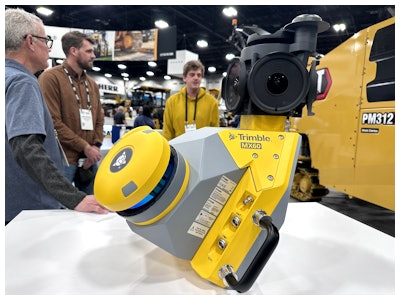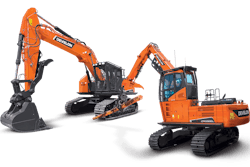
World of Asphalt is where you go to see the latest and great the industry has to offer. You go expecting to see what the future of the industry might look like. Every now and then, you get a glimpse of what could really be. This year, out of everything that I saw in the sprawling floor of booths, my attention lingered on one technological solution above the various others.
The Trimble MX-60 scanner is a data nerd's dream, and its capability to gather up to 4 million data points is only the beginning. It can capture 360-degrees of data with its field of view, including road conditions and surrounding contextual features. It is then able to create data-rich point clouds for feature extraction and machine modeling. This helps stakeholders, such as contractors and owners, with maintenance, bidding, and project management every step of the way. But this is also a play for the future.
In the complex world of construction and infrastructure management, data has become the new currency of success. Trimble's innovative Common Data Platform, which they were showcasing at World of Asphalt 2025, wants to transform how projects are conceived, executed, and documented. Thus, offering a comprehensive solution that addresses long-standing industry challenges.
Not the least of which is how government contracts are coming with more and more data-driven requirements. Uncle Sam wants to know exactly what they're getting for tax payer's money. That's something we can all appreciate, but for the contractors, it means being able to show them, in as much detail as possible, what work was completed, and does it reflect the intended spec and design.
They also want access to the jobsite data for any and all future work. Ten years from now, they might have a different contractor coming behind you to do some work, and they want to be able to show them exactly what was done prior. Over time, this refining and tracking of an infrastructure asset's history will reveal valuable trends, as well as, save valuable time and resources for each successive project.
"We're talking about working this construction continuum," explained Karl Bradshaw, Marketing Director of Mobile Mapping at Trimble, highlighting the platform's holistic approach to project management.
The platform begins with an unprecedented level of data capture, utilizing advanced technology like the Trimble MX 60 scanner - a sophisticated 360-degree camera and LIDAR package that transforms physical environments into rich digital landscapes.
"We do a lot of rehabilitation in this country, particularly, we're not building a ton of new roads," he said. "Because it's 360 we're getting everything. We're getting the building facades, the curbs, the stop signs, the fire hydrants, and the road condition. Now the owner has an indication of where am I, where's my worst quality surface? They could lay that over a traffic map, see where the road is the worst, and then decide where to spend [their] maintenance dollars."
But it's not just for the client's benefit, there's a lot of value in the data for contractors too.
"The contractor might also care about the quality or the condition report of the road, because some DOTs now are actually paying [based on it], the incentive comes on percent improvement of IRI or smoothness. That's a new benchmark," Bradshaw continued. "If it starts at a 150, it's a pretty bad road, but if you get it to a 130 you get this much. If you get it to a 95, you get this much. So the contractor wants to know, potentially, the quality of the road they're working with, and it helps affect the bid that they're going to submit."
Eliminating The Fog Of War
Traditional surveying methods often relied on limited data points and manual measurements. This new Common Data Trimble platform revolutionizes this approach by capturing millions of data points in minutes.
"Today, they went out and surveyed with a pole, getting 40 points in two hours," Patrick DiMeco, Sales Engineer at Trimble. "Now, we can capture 4 million points in just five minutes."
This isn't just about quantity, but quality. The scanner captures an incredibly detailed digital representation of a project site. Artificial intelligence then analyzes this data, identifying features, measuring road conditions, and providing actionable insights for project stakeholders.
In war times, the difference between the most recent intelligence you possessed about your enemy, troop movements, deployed artillery, or stronghold, and the present reality of their accurate locations, was called the fog of war. It represented the uncertainty between a data measurement in one point and time, essentially, and how it might have drifted or changed.
In construction, this represents the uncertainty between planned conditions and actual site realities. The Trimble platform systematically seeks to eliminate or effectively reduce these uncertainties to near-zero by providing continuous, precise documentation.
"We're cutting through the fog," said DiMeco said. By scanning sites at multiple stages - pre-construction, post-milling, and post-paving - contractors can track exactly what changes occurred and why.
Seamless Workflow Integration
One of the platform's true strengths lies in its ability to integrate multiple project stages. From initial surveying to design, bidding, construction, and final documentation, it creates a seamless workflow that reduces errors and increases efficiency.
"Once we've mapped the data, we can develop budgets, estimate costs, deploy resources, and track production in real-time," explained Bradshaw.
This means contractors can make more informed decisions, reduce unexpected costs, and improve overall project outcomes. Unlike some closed ecosystems, Trimble emphasizes open integration.
"We're not forcing everyone into a Trimble-only world," Bradshaw said.
The platform supports open APIs and can integrate with various scanners, machine control platforms, and existing systems. This approach recognizes the diverse technological landscape of modern construction, ensuring that companies can adopt the platform without completely overhauling their existing infrastructure.
The platform's versatility becomes clear through practical examples. In one scenario, a residential neighborhood project demonstrated how the technology could catch critical discrepancies. By scanning at different stages, contractors could identify issues like curb height variations that might otherwise lead to significant additional costs.
"If the curb is a half-inch higher than planned, that could mean extra asphalt costs across an entire subdivision," Kevin Garcia, GM of Civil Specialty Construction, said.
The ability to catch and address such issues before they become expensive problems represents significant value for contractors.
Future-Proofing Through Digital Twins
Perhaps the most exciting aspect of the Trimble platform is its ability to create comprehensive digital twins of infrastructure projects. By maintaining detailed, geo-referenced documentation, organizations can:
- Track project evolution
- Plan future maintenance
- Provide precise historical documentation
- Reduce potential legal disputes
"You will eventually get sued," one nearby contractor candidly shared, which highlighted the importance of maintaining detailed project documentation.
The Common Data platform automates this for the user, while recognizing potential user hesitation. So, Trimble designed the platform to be user-friendly. The system can be mounted on various vehicles, from site trucks to ATVs, and features an intuitive mobile interface.
"You don't need to be a qualified surveyor to use this," Dimeco said, highlighting the platform's accessibility.
A New Era of Construction Management
The Trimble Common Data Platform represents more than just a technological solution - it's a fundamental reimagining of how construction projects are conceived, executed, and documented. By providing unprecedented visibility, reducing uncertainties, and creating rich, actionable data sets, the platform empowers organizations to work smarter, not just harder.
As infrastructure challenges become more complex, technologies like this will move from being innovative options to essential tools for competitive organizations.
"We're not just collecting data," Garcia concluded, "we're creating a comprehensive ecosystem that drives quality, efficiency, and innovation."





